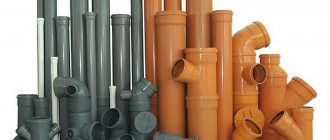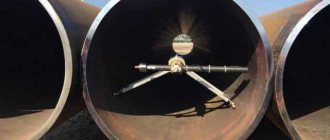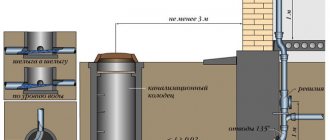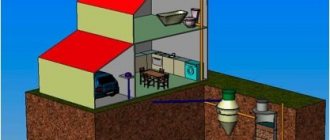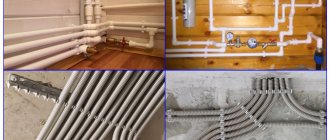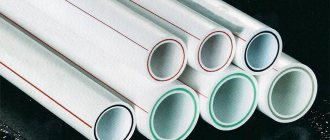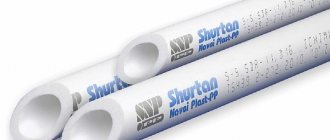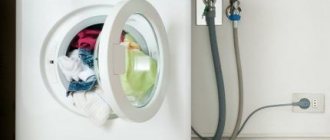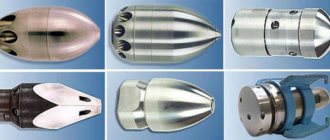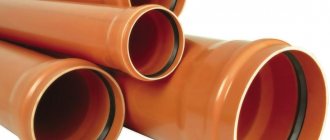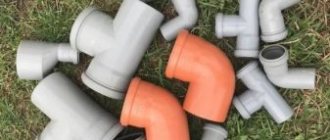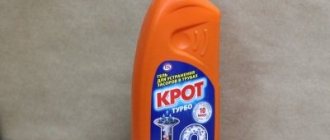If you buy good pipes, the sewer system will last for decades. In the article we will tell you how and which pipes to choose.
Three factors play a role in pipe selection: material, pipe location, and fittings. The material of the pipes determines their reliability and durability.
Depending on the location: for external and internal sewerage, the requirements differ. External sewerage - underground on the street. The inner half goes underground and half comes from toilets, sinks and showers throughout the house.
The availability and range of fittings have a lesser influence on the choice of pipes, but they determine the ease of installation of the sewer system. Let's first consider two types of sewerage: internal and external.
External sewerage
The external sewer system runs underground on the street and carries wastewater to the septic tank. Pipes for external sewerage can withstand static and dynamic loads:
- soil pressure,
- movement of people
- traffic,
- groundwater movement,
- temperature changes,
- humid environment,
- aggressive environments.
Dynamic loads. These are all variable loads: movement of cars and people, movement of groundwater. Pipes with high ring stiffness can withstand dynamic loads well.
Static loads. These are loads that constantly put pressure on the pipeline: soil pressure. Products with high ring rigidity also resist pressure well. Static loads also include others; we will consider them separately.
Temperature changes. The most dangerous are cold snaps, since many pipes can withstand 30-degree heat, but cannot cope with 30-degree frost.
Therefore, sewerage pipes are placed below the freezing level of the soil and are made frost-resistant. The freezing level is different for each region. For the Leningrad region, for example, 1.16−1.71 meters - depending on the type of soil.
Wet environments. High humidity in spring and autumn destroys ferrous metals without anti-corrosion coating and some other materials. Groundwater movement can dislodge the pipeline if it is not installed correctly.
Aggressive environments. These are acids, salts and alkalis that are found in soil and wastewater. Therefore, pipes inside and outside must be resistant to various substances.
Internal sewerage
Internal sewerage runs in the house itself and is connected to the external one under or through the foundation. For the internal pipeline, rigidity is not so important; the load on it is several times less. But other general requirements remain:
- Durability. Nobody wants to change the pipeline every two or three years. Especially when there are materials with a service life of 50 years or more.
- Easy replacement. To replace old sewers, major repairs are carried out. It is better if the pipeline can be easily replaced in case of breakdown.
- Soundproofing. Pipes for internal sewerage must isolate the sounds of sewage movement from the inhabitants of the house.
- Ease of installation. Some plastic pipes can be easily installed by a non-professional. The easier the installation, the faster the sewer construction takes place.
- Non-toxic. Pipes must be non-toxic and not release toxic substances upon contact with wastewater.
- Smooth inner surface. The sewer will silt and become clogged if the inner walls of the pipes are rough.
In addition, the internal and external water pipes must be easily connected to each other. If they do not connect well, the joint between them will become clogged or leak. This is especially important when partially replacing the pipeline.
Go ahead. Let's consider which pipes are most suitable for sewer systems:
- PVC pipes,
- PE pipes,
- PP pipes,
- asbestos-cement,
- concrete,
- cast iron,
- ceramic.
Features of installation and laying of plastic sewerage
Plastic sewer pipes are not able to absorb acoustic vibrations and vibration, like cast iron, for example. Plastic is a light and thin material. Cast iron products dampen sounds due to their mass, and plastic structures act as a resonator.
PVC pipes transmit vibration and noise the most, and polyethylene to a lesser extent. Thus, when laying the system, plastic sewer pipes must be covered with noise-insulating material or stretched in a box.
When soldering a cut pipe to a socket, the structure must be cleaned. Any irregularities that remain on the inside wall of the pipe will collect solids from the drain. If the joints are joined with force, you can use some kind of lubricant: grease, glycerin, any soap.
When installing the system, plastic sewer pipes leaving the house are pulled with a slight slope (1-2 cm per meter of pipe), then the wastewater will not be retained in the sewer. The pipes are secured using clamps and latches.
When assembling the riser, it is necessary to secure the neck of each pipe with a clamp. If a compensating pipe is installed, it is secured in the same way.
Please do not count on the fact that plastic pipes will only need O-rings. Over time, they become loose and the joints may become depressurized.
Since plastic pipes tend to sag from their own weight, horizontally located pipes with a diameter of 110 mm and above must be secured with hangers and clamps at a distance of at least one and a half meters.
If it is planned to lay plastic sewerage under highways, then the pipes should be laid to a depth of at least one meter. If the possibilities do not allow deepening, then they will need to be stretched in a reinforced concrete box.
To clean sewer risers, steel wire is usually used, which is not suitable for plastic construction. The wire can severely scratch the inner walls of the plastic. Therefore, it is best to use a soft cable, which is protected at the end with a rubber tip. The simplest method to clean a plastic drain without damaging the inside of the pipes is to disassemble the connection and remove the blockage.
PVC pipes
PVC or uPVC - polyvinyl chloride, a new polymer material. PVC pipes are lightweight, environmentally neutral and easy to install.
Advantages:
- long service life,
- no overgrowth,
- resistance to acids,
- wear resistance,
- ease.
Flaws:
- inoperability at temperatures below −10°C,
- deform (elongate) at temperatures above 60°C.
Gray PVC pipes are excellent for indoor sewerage, where they are used. Red PVC pipes for sewerage with hardness SN-4 and higher can be used for external pipelines.
To connect, the pipes are inserted into each other: at one end of the pipe there is a socket with a rubber ring, and at the other there is a chamfer that is tightly inserted into this socket. The inner surface of PVC pipes is perfectly smooth, so they rarely become clogged or overgrown.
Such pipes should be buried deeply, otherwise they will freeze. Also, you should not drain liquids with a temperature above 60°C through them for more than a minute. For a short time they can withstand temperatures exceeding 95°C.
The rigidity of plastic pipes: what does the color mean?
The rigidity of plastic pipes is closely related to strength. To differentiate products, manufacturers usually paint them in different colors. The light brown color of the pipeline means that it is intended for arranging a waste system indoors. Orange-brown products are intended exclusively for the construction of external networks.
Products differ from each other according to their hardness class:
- SN2 - used for the construction of wastewater systems where there is no vehicle traffic.
- SN4 - used where there is moderate traffic.
- SN8 - used for the construction of sewerage systems where there is intensive movement of heavy vehicles.
When choosing plastic products, attention is paid to the rigidity class, which will extend the service life of the system.
PE pipes KORSIS and KORSIS Eco
Polyethylene is another polymer. KORSIS and KORSIS Eco pipes are made of high-density polyethylene (HDP) and an external corrugated layer is added. It increases ring rigidity, so the products are suitable for external sewerage.
Advantages:
- durability,
- ease,
- elasticity,
- frost resistance down to −60°C,
- resistance to acids and alkalis,
- soundproofing,
- polished inner surface.
Flaws:
- sensitivity to sunlight,
- maximum temperature of the transported substance: 80°C.
Pipes made of high-density polyethylene, unlike PVC, tolerate low temperatures. At the same time, they are also lightweight, elastic and more reliable for external pipelines.
sells polymer pipes made of PVC and high-density polyethylene. SIS is the official distributor of the Poliplastik Group, a manufacturer of plastic pipes for sewerage, water supply, and heating. SIS sells products from the Polyplastic Group at prices from the manufacturer, and also helps you choose material for pipelines.
Manufacturers
Particular attention should be paid to the quality of pipe manufacturing. As a rule, all defects are immediately visible on the surface of the product, but sometimes the manufacturing material does not meet the stated technical conditions, which sharply reduces the service life. It is recommended to use products from the following manufacturers:
- Wavin (Netherlands) . Polymer pipes for domestic and external gravity sewer systems. Pragma double-layer corrugated pipes made of polypropylene are especially popular on the domestic market. Their locking connections have improved seals.
Methods for connecting corrugated pipes “Pragma” PHOTO: vsap.ru
- Polyplastic (Russia, Belarus, Kazakhstan) . Produces a wide range of pipes with a diameter of 40-600 mm from polyethylene, polypropylene, PAKH, fiberglass. Particular attention should be paid to the Korsis series, which includes double-layer and reinforced pipes. These products have a characteristic appearance - an outer corrugated layer (black) and an inner smooth surface (yellow, orange, light blue).
Pipes and fittings of the Korsis series PHOTO: images.ru.prom.st
- Ostendorf (Germany) . It has factories all over the world, including in Russia since 2011. Produces pipes, fittings and shaped products from high-strength polyvinyl chloride without impurities. The KG product line is worthy of special attention.
Pipes and fittings manufactured by Ostendorf KG series PHOTO: docplayer.ru
- Duker (Germany), Saint-Gobain (France). Pipes are produced from cast iron using centrifugal casting. Diameter 75-200 mm. The products of these companies are quite similar both in price range and in their performance characteristics.
Installation sequence using special Duker overlays PHOTO: docplayer.ru
Below are photographic examples of the use of sewer pipes made of various materials
PHOTO: i.ytimg.com
PHOTO: i.ytimg.com
PHOTO: stroyklim.com
PHOTO: kanalizaciya-prosto.ru
PHOTO: santechsystems-21.ru
PHOTO: trubovar.ru
Non-standard use of sewer pipes.
PHOTO: i.pinimg.com
PHOTO: i.pinimg.com
PHOTO: i.pinimg.com
PHOTO: i.pinimg.com
You can additionally study the features of choosing sewer pipes and their classification by reading the proposed video.
PP pipes
Polypropylene or PP pipes are also a new plastic building material with high strength values.
Advantages:
- resistance to high and low temperatures,
- durability,
- ease,
- resistance to acids and alkalis,
- strength,
- ease of installation.
Flaws:
- instability to temperatures above 80°C.
The disadvantages of PP pipes relate to temperatures above 95°C and work with fire-hazardous objects. High temperatures have a bad effect on polypropylene, as well as on other polymer materials.
In general, this material is excellent for any sewer systems. PP pipes are used for storm drainage, in private houses and apartment buildings due to their strength and wear resistance.
How to choose the right sewer pipes by size and type
When choosing sewer pipes, they are guided, first of all, by the area of their use and the type of sewer system.
- Outdoor. The main requirements for external sewer pipes are a wide temperature range and resistance to external mechanical influences. If for domestic sewerage it is allowed to use thin-walled and smooth polypropylene and polyethylene pipes, then for main pipelines concrete, ceramic and steel products with improved strength characteristics are used. It is also allowed to use double-layer corrugated pipes made of polymers for laying highways under roads with medium traffic intensity.
Double-layer corrugated pipes for main sewer networks PHOTO: uz.all.biz
- Internal. For residential, commercial and a number of industrial premises, there are general requirements for the sewerage system, described in GOST R 56534-2015. All these requirements are fully met by polymer pipes: PVC, polyethylene or polypropylene. Considering the wide range of standard sizes, light weight and ease of installation, at the moment other materials practically cannot compete with them. Only some chemical and food industry enterprises use ceramic and metal pipes for industrial sewage systems.
Plastic pipes are available in the same sizes as cast iron pipes and are completely compatible PHOTO: i.ytimg.com
- Pressure. A pressurized sewer system is usually used centrally to pump wastewater to treatment plants. Its elements are subject to special requirements for the strength of not only the pipes themselves, but also their joints.
They are required to:
- versatility - the ability to transport wastewater of various types;
- resistance to water hammer;
- low susceptibility or complete inertness to chemical and biological corrosion;
- strength to static pressure;
- manufacturability and high speed of installation combined with reliability of connection points.
All these criteria are met by pipes made of uPVC or high-density polyethylene, although cement pipes are still quite common. The main parameter of a pressure sewer pipe is the maximum pressure of the working medium - MOP.
Welding of PVC-U sewer pipes PHOTO: ingtechgroup.ru
- Non-pressure. Gravity sewer pipes are not subject to such stringent operational requirements as pressure ones, in particular, the ring stiffness parameter. However, they must be sufficiently strong to withstand internal pressures of up to 5 bar (4.93 atm). Their diameter should be selected so that the filling degree does not exceed 80%.
Laying a gravity-flow sewerage pipe PHOTO: polyplastic.ua
Related article:
In this article we will look in detail at how to create a sewerage system in a private house with your own hands with step-by-step photos and videos, and also learn how to choose the right pipes and fittings for its arrangement.
Asbestos cement pipes
Asbestos-cement pipes are durable, which is why sewer pipelines are made from them. Cement and asbestos fiber are not destroyed by rot, acids or corrosion.
Advantages:
- cheapness,
- durability,
- resistance to acids, alkalis, aggressive environments,
- strength,
- ease of installation,
- resistance to clogging.
Flaws:
- fragility, instability to mechanical stress,
- harm to people and the environment.
Given their low cost and durability, asbestos-cement pipes are not the best option. They are more difficult to transport and install than polyplastic - the weight is higher than that of polymers.
Also, asbestos cement crumbles at the edges, which is why the tightness is compromised if the connections are incorrect or of poor quality. The most dangerous, especially for internal connections: the environmental damage of asbestos concrete. Asbestos releases carcinogens; it is dangerous to work with and live near it.
Technical and operational characteristics of various pipes and connections
There are various types of sewer pipes on sale. The materials from which sanitary products are made differ in a number of properties from each other.
The choice of material depends on the purpose of the utility network.
Polyvinyl chloride
Polyvinyl chloride sewer systems are made on the basis of polyvinyl chloride thermoplastic - a material that, as a result of high-temperature processing and extrusion procedures, retains its shape well. There are products made from plasticized and unplasticized PVC, but their characteristics are almost the same.
Polyvinyl chloride sewer pipes.
Polyvinyl chloride has many advantages. With a sufficiently high level of strength, its weight is light, which makes assembly and installation of the sewer convenient.
Due to the low temperature coefficient of expansion, polyvinyl chloride products hold their shape, do not sag, do not melt, and do not increase in length when placed in a warm room or during short-term heating.
PVC pipes are tested for impact strength even at the production stage. In addition, they are tested for changes in length as a result of heating. These tests are regulated by the relevant GOST.
The internal surface of PVC pipeline elements is almost smooth, so the likelihood of sediment accumulation and blockages is extremely low.
Polyvinyl chloride is not subject to corrosion and is resistant to chemically aggressive environments (acids, alkalis, etc.). Bacteria do not linger or multiply on the surface of polyvinyl chloride products, which indicates the high hygienic qualities of the material. Polyvinyl chloride is quite resistant to temperature fluctuations; the operating temperature range is from -15°C to +66°C.
Assembling a sewer system made of polyvinyl chloride is not very difficult and does not require the use of special equipment. A large selection of utility network elements facilitates the design of a sewer system. On sale you can find polyvinyl chloride pipes of various sizes for any purpose. It simplifies installation and eliminates the need to ground the pipeline (PVC does not conduct electricity). The service life of polyvinyl chloride products is about 50 years.
The disadvantages of polyvinyl chloride systems include instability to elevated temperatures: with prolonged exposure to temperatures of +70°C and above, the material becomes brittle and loses elasticity. Polyvinyl chloride is highly flammable, releasing phosgene when burned. Another disadvantage of PVC is its instability to concentrated organic solvents, which change the structure of the material.
Made from polypropylene
The main advantage of polypropylene is the low weight of products. This simplifies the installation of sewerage. At the same time, polypropylene systems are characterized by strength and wear resistance. Polypropylene is elastic, as a result of which, under mechanical stress, it is slightly deformed, maintaining integrity, and is restored to its original state.
Sewage pipes made of polypropylene.
Polypropylene is not subject to corrosion. It can be used to remove aggressive substances (acids, alkalis, etc.). Products made of polypropylene can withstand exposure to open fire and do not emit harmful substances. The service life of polypropylene products reaches 100 years.
Polypropylene, unlike polyvinyl chloride, has a wider range of operating temperatures - up to +70°C with short-term increases to +95°C. In this regard, the installation of polypropylene systems is more applicable in a house or apartment where there are household appliances that discharge waste hot water into the sewer.
However, the material is poorly resistant to low temperatures: cracks may appear even at -15°C, so polypropylene sewers must be additionally insulated.
Polyethylene
Polyethylene products are made from two types of polyethylene: high-density polyethylene and low-density polyethylene.
Products made from polyethylene have a number of advantages. This material is not subject to corrosion and does not react with chemically aggressive substances, so it can be used to remove acids, alkalis and other compounds. Polyethylene is lightweight, which simplifies pipeline assembly. The service life of polyethylene products reaches several decades.
Sewage pipes made of polyethylene.
Polyethylene pipes have a smooth inner surface. Thanks to this quality, there are no deposits on them that lead to blockages. Polyethylene products are characterized by flexibility and impact resistance.
Another property of polyethylene is low thermal conductivity. Thanks to this, condensate forms on the elements of the utility network in a minimum amount.
Polyethylene is resistant to low temperatures (up to -70°C), but is prone to softening when exposed to temperatures above +80°C, so it is not recommended for use in systems where hot water is drained.
Polyethylene is less wear-resistant than polyvinyl chloride and polypropylene.
With regular abrasive exposure to waste rich in solid particles, the surface of polyethylene quickly loses its smoothness and becomes rough, which leads to the accumulation of sediments and sewer blockages.
Metal pipes
The main advantage of metal products is temperature resistance. Metal provides strength and a high level of sound insulation. Metal sewer pipes are made of steel and cast iron.
Metal sewer pipes.
Steel structures
Steel structures guarantee strength and provide rigidity to the sewer system. The material maintains the slope angles of the system and withstands high temperature loads.
Steel sewer pipes.
However, steel sewer systems have many disadvantages. Thus, steel in its pure form is susceptible to corrosion, so products are coated with paint or treated with bitumen, and when a waterproofing layer is applied, the resistance of the material to temperature influences decreases from +700°C to +60°C.
The joining of sewerage elements is carried out by threaded connections or welding, which increases the vulnerability of steel to corrosion. Due to rust deposits on the inner walls of the steel pipeline, its clearance narrows, which causes blockages. In addition, the cost of steel pipes is higher than plastic ones.
Cast iron pipes
Cast iron sewers are more wear-resistant than steel ones. Its other advantages include high strength, environmental safety, good level of sound insulation, fire resistance, resistance to chemicals and mechanical factors, and a wide range of operating temperatures. The service life of cast iron products reaches 100 years.
Cast iron sewer pipes.
However, cast iron products have many disadvantages. Cast iron, like steel, is susceptible to corrosion, so the inside of a cast iron pipeline is coated with enamel or treated with bitumen. This measure also makes it possible to partially smooth out the roughness of the internal surface of the sewer.
However, despite this, accumulations of rust and other deposits often cause blockages in cast iron sewer networks. In addition, cast iron products are susceptible to pinpoint impacts.
Other disadvantages of cast iron sewers include the high cost and labor-intensive installation work - a consequence of the large weight, which makes it difficult to manipulate the products.
Alternative materials - asbestos cement and ceramics
Ceramic sewer pipes.
The basis of asbestos-cement pipes is Portland cement and asbestos fibers. The service life of products made from this material reaches 25 years. They are characterized by lightness, resistance to chemicals and are not subject to corrosion.
Asbestos cement pipes can withstand prolonged exposure to temperatures up to +160°C, but have low strength. They often become clogged due to the roughness of the internal walls, are difficult to install and are available in a limited range of standard sizes.
Ceramic sewerage is characterized by resistance to corrosion (100%), immunity to aggressive environments (acids, alkalis, etc.), heat resistance (withstands temperatures of +1000°C and above). Its inner walls are smooth, which prevents the formation of deposits on them.
The service life of ceramic pipes reaches 150 years. However, ceramics are rarely used in sewerage installations. Ceramic products are fragile and heavy, which complicates the installation of the sewer network.
Concrete and reinforced concrete pipes
This is heavy artillery. This sewage material is used in industrial buildings: factories or wastewater treatment plants.
Advantages:
- resistance to mechanical loads,
- durability,
- resistance to corrosion,
- cheapness.
Flaws:
- heavy weight,
- complexity of installation,
- rough inner surface.
Concrete is a cheap, durable and sustainable material. But using it for the construction of a private home sewer system is unjustified: it is unlikely that there will be such high loads there, except perhaps for organizing a septic tank.
But transportation and installation of pipes will be expensive and take a long time. For example, the installation site is prepared: the soil is additionally compacted. Concrete and reinforced concrete are suitable for the construction of septic tanks. Concrete rings are strong and durable, so the septic tank most likely will not have to be replaced for several decades.
Cast iron pipes
Cast iron pipes are divided into gray cast iron and ductile iron materials. Gray cast iron does not resist dynamic loads well: for example, cars passing over a sewer line. Malleable cast iron perfectly withstands any load and, unlike other ferrous metals, does not rust.
Advantages:
- high strength,
- durability,
- resistance to low and high temperatures,
- simple installation,
- corrosion resistance.
Flaws:
- heavy weight,
- roughness of internal surfaces,
- instability to salts and saline solutions,
- high price.
To bring and install cast iron pipes you will need special equipment. The costs of the material itself add up to the costs of building a sewer system. However, after installation, the sewerage system does not guarantee a long period of flawless operation due to the possibility of silting.
Rules for installing sewerage systems made of plastic pipes
There are several rules, the application of which in practice will make it possible to create a strong and reliable sewer system. When installing sewerage from plastic pipes, you should adhere to the following recommendations:
- Make a slope in the place where the pipe leaves the plumbing fixture. The slope angle depends on the purpose of the device and is on average 30 0.
- Avoid perpendicular joints. If the system turns by 90 0, it is better to make two turns of 45 0. A perpendicular joint is a potential source of clogging;
- Place the toilet as close to the riser as possible so that sewage immediately goes into the sewer;
- At branch points, install inspection fittings designed to clean the system in case of contamination;
- Do not leave pipes open. Plastic ones are a source of noise. This especially causes a lot of inconvenience to residents of apartment buildings. Such pipes should be placed in polystyrene foam, and then special boxes with windows in the places of inspection fittings should be built over them;
- Before installing connected pipes to the system, they should be checked for leaks, paying attention to the joints.
We recommend that you read: How to install a damper for a stove chimney?
Ceramic pipes
This is the most ancient material of all, which is gradually being used less and less.
Advantages:
- neutrality to chemicals,
- smooth inner surface,
- resistance to temperature changes,
- easy installation.
Flaws:
- fragility,
- short length of one pipe.
Ceramic products used to be excellent for sewerage. But now many other materials that are lighter or stronger have similar properties.
Fitting
Fittings also influence the choice of pipes for sewerage, although to a lesser extent. Fittings are pipeline connecting parts that allow you to branch, close, or direct pipes in another direction.
The most common fittings are for plastic pipes. They are made from the same polymers: PVC, PP, PE - they have different diameters and sizes and are easy to install. The range of metal fittings is more modest.
They are just as easy to install, but the parts themselves and their sizes are smaller. The same goes for ceramic fittings. For other types of pipes, fittings are not sold at all; they are connected differently. In terms of fittings, polymer pipes are better for sewerage.
Materials for sewer construction have many similar characteristics: immunity to aggressive environments, relative smoothness inside, strength.
But at the same time, plastic pipes are always light and, in addition, elastic. Installation and docking are simplified. At the same time, pipes made of different plastics are easily connected to each other.
Therefore, internal and external sewerage can be made from different, most suitable polymers. It is obvious that plastic pipelines are the future for both internal and external sewage systems.
Source: remstd.ru/archives/kak-vyibrat-trubu-dlya-kanalizatsii/
Types of sewer systems
Sewage systems can be external and internal. The internal system is a set of pipelines that ensure the removal of wastewater from all plumbing fixtures and their delivery to the common exit from the building. As a rule, most owners install internal sewerage with their own hands - and all thanks to plastic elements that are very easy to install yourself.
An external sewer system takes wastewater from a building and carries it into the complex for storage or treatment, after which the illuminated water is discharged into a pond or other place intended for this purpose.
There are different types of sewer pipes, which is especially true for external systems: products may differ in diameter, material and even cross-sectional shape.
There are the following types of sewer pipes:
- lightweight: suitable for sewers installed at shallow depths and not subject to serious physical stress. As a rule, domestic sewerage is made from such pipes;
- medium: used on not very busy roads and under small buildings;
- heavy: laid under highways and large houses.
No. 1. Material of internal sewer pipes
Internal sewerage can be done using the following pipes:
- cast iron. Previously they were installed everywhere, but today they are practically not used;
- polyvinyl chloride (PVC);
- polypropylene. Looking ahead, we note that this is the most optimal option;
- polyethylene. Infrequently used;
- steel and copper. Expensive pipes that are not used, but are sometimes still used due to their appearance.
Despite the fact that polypropylene and PVC pipes are most widespread, when choosing, do not rush to immediately discard the other options, since in some cases cast iron and even copper pipes may be useful.
No. 2. Cast iron pipes for internal sewerage
Several decades ago there was no particular alternative to cast iron pipes, so they are widely found in old houses. Today, cast iron is being replaced by plastic, but is still used.
Such pipes are made from gray cast iron by centrifugal casting. To protect the material from corrosion and make the internal surface smooth, the pipes outside and inside are coated with a bitumen compound. The diameter of cast iron pipes ranges from 5-15 cm, the wall thickness is 10-12 mm.
Advantages of cast iron pipes:
- durability. The service life reaches 50 years and often exceeds this mark. Some data suggests a longevity of 90-100 years;
- high strength and resistance to deformation. On the other hand, the material does not tolerate shock loads well;
- the ability to withstand long-term exposure to hot waste (from a washing machine or dishwasher, for example);
- resistance to temperature changes;
- fire resistance;
- environmental Safety;
- good sound insulation.
Surely, cast iron pipes would have remained among the leaders if not for significant shortcomings:
- the walls become overgrown with sediment over time. This is all due to the roughness of the material, which even with a bitumen coating cannot be completely eliminated. The process of overgrowing leads to a narrowing of the pipe lumen and a decrease in its throughput. Anyone who has seen what a pipe looks like after many years of use will never forget this terrible sight;
- heavy weight of pipes, which complicates transportation;
- complex installation, which is explained not only by the large weight, but also by the peculiarities of connecting pipe sections. In order for the sewer system to be airtight, it is necessary to correctly connect the elements. Usually they use the method of caulking or caulking using a heel; susceptibility to corrosion processes;
- high price.
Cast iron pipes are not used today to build a new sewer system, but they may be needed when existing systems are being reconstructed.
At the moment, the use of cast iron pipes is also justified when arranging external sections of private sewers and intra-house risers.
When choosing, it doesn’t hurt to carefully examine the products and tap each of them. This way, it is easy to detect cracks and other defects that form when the manufacturing process is disrupted.
A defective pipe does not have a long service life. Various types of fittings, plugs and sockets are produced for connecting cast iron pipes.
How to choose pipes: expert advice
Experts say that installing sewer systems is much more difficult than installing heating or plumbing. Mistakes in arranging a sewerage system can have very unpleasant consequences.
In order to avoid them, you should adhere to the following recommendations:
- All internal pipes intended exclusively for water may have an internal diameter of no more than 5 cm.
- Pipes intended not only for water must have a diameter of 10 cm;
- Preference should be given to plastic pipes, since they are less susceptible to corrosion and contamination.
- When connecting washing machines and dishwashers to the sewer system, it is worth remembering that the water temperature in them reaches 90 0 C.
- The diameter of the pipes can change from smaller to larger, but not vice versa.
- When choosing polyethylene as a material, it is worth installing LDPE for internal sewerage, and HDPE for external sewerage.
It is important! PVC pipes must not be installed at the outlet of the washing machine or dishwasher. Such pipes are not heat-resistant; under the influence of high temperatures they begin to melt. It is better to use polypropylene to drain water from various devices.
No. 3. Polyvinyl chloride (PVC) sewer pipes
For arranging internal sewerage, PVC pipes are considered almost the most suitable option. During the production process, some other substances are added to polyvinyl chloride, which include stabilizers and polymers. Elements of the required shape are formed from the heated mass.
PVC pipes can be of two types:
- pipes made of plasticized PVC (PVC) have good elasticity and low strength;
- pipes made from unplasticized PVC (PVC-U) are more rigid and resistant to aggressive influences.
Of course, it is better to use unplasticized PVC, but in practice both types of pipes are used. The diameter of the products ranges from 2 to 20 cm.
Main advantages:
- affordable price;
- light weight;
- ease of installation. Separate sections of pipes are connected by couplings and connecting rings - everything is done without welding;
- low temperature coefficient of expansion. With a short-term or constant increase in the temperature of the drains, the pipes will not sag;
- sufficient strength and durability up to 50 years;
- sufficient resistance to ultraviolet rays, so that some sections of pipes can not be afraid to run on an open surface;
- resistance to corrosion and some aggressive substances;
- Thanks to the smooth inner surface, the walls do not silt over time
Minuses:
- limited operating temperature range. With constant exposure to negative temperatures, pipes become fragile and lose their tightness, and with constant exposure to temperatures above +60...+700C, the material can deform and also lose integrity;
- insufficient fire resistance;
- The inner walls of PVC pipes are smoother than those of cast iron, but over time they will still develop plaque. In addition, the internal diameter changes over the years. As a result of exposure to high temperatures, the circular cross-section is transformed into an ellipsoidal one, and this impairs the throughput and contributes to the occurrence of leaks;
- some aggressive substances contained in drains can still lead to the gradual destruction of pipes.
To install internal sewerage from PVC pipes, appropriate connecting elements are used. These include an elbow designed to rotate the pipeline at an angle from 20 to 87 degrees, a tee for arranging branches, a cross for connecting four pipes, and a reduction for connecting sections of pipes of different diameters.
Spiral twisted polyethylene pipes
Spiral pipes with a closed profile cavity are made from pipe polyethylene (grades from 63 to 100).
The cylindrical drum rotates, a profile is wound onto it continuously, simultaneously welding the turns to each other. The geometry of this profile gives the pipe high resistance to deformation. Spiral sewerage pipes made of polyethylene are used in non-pressure sewerage systems (stormwater, technical) with a pipeline diameter of more than 1 m.
Installation of polyethylene pipelines is carried out using the following types of connections:
- Detachable connections are used when dismantling is necessary and are divided into: socket; flanged using steel flanges; collet using compression fittings.
- Permanent connections: butt welding; coupling welding.
Detachable and permanent connections of PE pipes
High-density polyethylene sewer pipes are connected to each other using compression fittings, for example, when repairing a failed section of the system. Also, the use of compression fittings allows the assembly of pipelines from different types of materials. When installing a sewerage system with a diameter of 110 mm (with increased requirements for the elasticity of the parts being connected), compression fittings are used, facilitating the installation process.
Compression fitting installation process
Butt welding is considered the most effective type of connection of PE products. Pipes and other structural elements, after butt welding, have the characteristics of a monolithic pipe. Welding polyethylene pipes requires quite expensive equipment, which increases the cost of laying a sewerage system.
Coupling and welding machine
We hope that the information presented has helped you understand what sewer pipes made of polyethylene are. If you have questions about assembly, we recommend that you read the article “Installation of polyethylene pipes.”
Sewer pipes are one of the components of modern communications.
They carry away waste generated in both private and apartment buildings. More recently, a quarter of a century ago, drain pipes were made exclusively of cast iron and steel. Some apartments and houses still have systems made from old pipes.
No. 4. Polypropylene sewer pipes
Polypropylene pipes today are actively used in the arrangement of heating systems, cold and hot water supply. The properties of a material strongly depend on its structure.
Pipes made from a copolymer of propylene and ethylene (PPR) are suitable for internal sewerage; they can withstand temperatures up to +700C. PPs type pipes behave even better, they can easily withstand temperatures up to +950C and short-term exposure to even higher temperatures.
Reinforced pipes will be more durable, and fiberglass reinforcement is considered optimal. The product labeling also indicates the operating pressure: for internal sewerage, PN10 pipes will be sufficient (withstand 1MPa), but more often they take PN20.
Advantages:
- durability up to 50 years;
- resistance to corrosion and almost all aggressive substances (acids, alkalis and salts will not damage the material);
- high strength of pipes and connections. Polypropylene is stronger than polyethylene and PVC, it is more resistant to cracks, and joints are less likely to depressurize;
- light weight;
- an absolutely smooth inner surface, so there will be no problems with pipe overgrowing;
- resistance to high and low temperatures, which allows the pipes to be used in almost any conditions. The pipes are not deformed;
- relative ease of installation. The connection of individual sections is made with a special welding machine, which almost anyone can learn to work with;
- relatively low price, but polypropylene pipes will cost more than polyvinyl chloride pipes;
- polypropylene type PPs belongs to the group of flame-resistant materials.
Among the disadvantages of polypropylene pipes, one can note only temperature deformation, so they will either have to be insulated or equipped with compensators.
Ancient technology
Those homeowners who want to avoid this problem use pipes made of a completely different material. These are ceramic pipes. A very long time ago they were already used for sewage, for example, by the ancient Romans. However, later, for many historical reasons, sewage problems faded into the background, even later new materials appeared, and ceramics were forgotten for a long time. However, today ceramic pipes have received a new life, and it turns out that they are perhaps the only effective means for draining sewage waste from all those existing in modern conditions.
Firstly, ceramic pipes are very easy to manufacture and install. Secondly, they are not subject to corrosion, since the clay from which ceramics are made does not rust. Thirdly, the inner walls of ceramic pipes are as smooth as steel or plastic; blockages do not form in such pipes. Fourthly, ceramics is a natural material, therefore environmentally friendly, and can be used not only for sewerage, but also for water supply, both outside and inside the house. You can also add here the excellent frost resistance of ceramic pipes, which allows them to be used in regions with difficult climatic conditions. The only disadvantage of ceramics is that the strength of this material is low compared to cast iron, but if such pipes are laid correctly and properly maintained, then they can serve, without any exaggeration, for centuries.
No. 5. Polyethylene sewer pipes
Polyethylene pipes are rarely used in the construction of internal sewage systems. Typically, either low-density polyethylene or cross-linked polyethylene is used.
The first option can withstand a maximum of +400C, so it makes sense to use it only in places with cold drains. Cross-linked polyethylene is designed to operate at temperatures of 0...+950C; for a short time it can withstand temperatures from -50 to +1200C, so it is usually used.
The material has the following advantages:
- high strength, wear resistance and flexibility;
- corrosion resistance;
- smoothness of the walls and almost complete resistance to the formation of growths;
- light weight;
- resistance to pressure changes;
- durability;
- flexibility and easy installation;
- relative availability in terms of price.
Minuses:
- fear of ultraviolet rays;
- Oxygen can pass through the material, which will damage the metal elements in the system. The manufacturer applies a special coating, but it is quite delicate, so during installation you must be extremely careful so as not to damage it;
- low abrasion resistance
What types are there for external and internal work?
Currently, the choice is so diverse that you have to familiarize yourself in detail with the technical characteristics of each type so as not to make a mistake in your choice. Sewer pipes may vary:
By area of application. It is necessary to distinguish between pipes for external and internal systems. The former are affected by low temperatures, down to minus 10-20 degrees Celsius.
External pipes are subject to mechanical stress (pressure) and must withstand contact with the ground. By materials. Pipes are made of various materials. Only plastic can have several varieties, which differ from each other in appearance and technical characteristics. In appearance. They can be smooth and corrugated. Smooth pipes prevent the formation of blockages, while corrugated pipes have high strength.
Corrugated pipes can be smooth on the inside and ribbed on the outside. They withstand mechanical loads associated with compression much better. By size. Here there is both the size of the pipe section, which are manufactured in 50, 200 cm, etc., as well as the outer diameter and thickness of the pipe wall.
In an apartment building, the owner deals only with pipes for interior work.
They must withstand temperatures of about 70 degrees and for a short time - 90-95 degrees. In a private house, when external wiring is carried out, such elements will no longer be required, since the environment and mixed drains reduce the temperature. In addition, pipes that can withstand elevated temperatures are more expensive.
No. 6. Copper and steel sewer pipes
Copper and steel pipes can be called ideal in terms of durability, strength and corrosion resistance. They can withstand any temperature and pressure, are characterized by minimal thermal expansion, and have a smooth, non-overgrowing inner surface.
The main disadvantage is the high price. In addition, copper pipes require specific installation, which only a professional can handle.
It is justified to use such an extravagant version of sewer pipes when open installation is carried out, and plastic pipes will look ridiculous. Copper pipes are often used when creating a retro interior with a claw-foot bathtub.
Corrugated PE pipes
Twin-screw extrusion makes it possible to produce double-layer pipes.
The walls formed by the hot method form a monolith. The cavities obtained between the walls greatly facilitate the construction. The outer corrugated wall provides the required ring rigidity, and the smooth inner wall provides the necessary hydraulic characteristics.
P/E sewer pipes produced by continuous extrusion are low in weight, greatly simplifying their installation and transportation. The couplings used with rubber seals ensure tightness. High resistance to deformation allows corrugated pipes to be laid to significant depths.
Corrugated pipes at the factory
No. 7. Size and diameter of sewer pipes
Before you start purchasing and installing sewer pipes, it is best to draw up a project where you indicate all the drain points and the type of plumbing equipment.
This will help you figure out what diameter and length of pipes are needed. At this stage, it also doesn’t hurt to determine the number of auxiliary parts, which will depend on the number of turns and branches. Take into account the change in pipeline diameter in individual sections.
Depending on the type of plumbing fixture being connected, pipes with different diameters are selected:
- a sewer pipe with a diameter of 25 mm is suitable for a dishwasher and washing machine;
- for bathrooms, showers and kitchen sinks – 40-50 mm;
- for washbasin and bidet – 30-40 mm;
- for pipe routing – 40-50 mm;
- bends from the riser – 65-75 mm;
- the central riser and pipe from the toilet are 100-110 mm.
It is better to add a margin of 10% to the calculated length.
Pos
Installation nuances
There are a number of nuances in the installation of sewerage systems, which, if ignored, can result in not a good drainage and drainage system, but, in Russian speaking, large hemorrhoids. So I will list as much as possible:
- When cutting pipes, the cut must be strictly perpendicular to the axis and must be processed with sandpaper;
- The elements to be glued must be degreased;
- Fittings with a rubber seal must be coated with silicone sealant;
- The cross-section of the horizontal pipeline should not exceed the diameter of the sewer riser;
- In places where the pipeline turns, it is necessary to install revisions - cleaning holes with a cover;
- Horizontal connections must be made from angles and oblique tees;
- Sewerage is secured at intervals equal to 10 x pipe diameter;
- The slope of horizontal sections should not exceed 1-2cm/1m;9. The bell is positioned towards the moving liquid.
